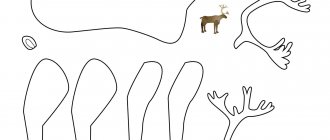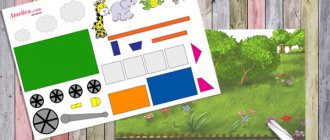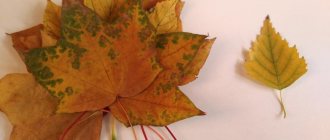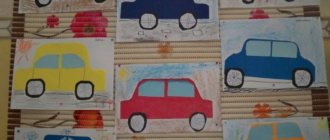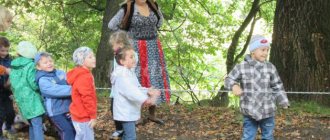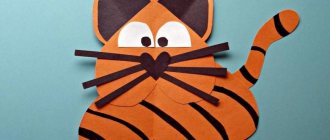Applications are a very popular form of creativity for children. The activity will be interesting for even a young child. The baby will be indifferent to drawing or modeling, but he will definitely be interested in cutting out figures and gluing them. Autumn applications look especially beautiful . Next, the application of autumn leaves will be presented; the preparatory group of the kindergarten will be able to cope with this master class.
Application “Autumn Leaves”
photo 1
In order to complete this master class, you need:
- scissors
- colored paper
- pencil
- leaf outline templates
photo 2
The technique can be compared to the technique of cutting out snowflakes. First you need to take a sheet of green paper.
photo 3
It is folded in half and a triangle is obtained.
photo 4
After this, the triangular-shaped workpiece is folded in half twice more.
photo 5
photo 6
At this stage you need to apply a template of an oak leaf image.
photo 7
This sheet is traced along the contour using a simple pencil.
photo 8
photo 9
Appliquing autumn trees from paper is quite simple. In order to make a birch leaf, it is better to take a yellow sheet of paper. The sheet is folded in exactly the same order.
photo 10
It is necessary to trace the outline of the leaf according to the template and cut it out.
photo 11
photo 12
In order to cut out a maple leaf, you need to take an orange sheet of paper.
photo 13
It is folded in the sequence indicated above.
photo 14
A maple leaf template is applied to the workpiece, folded in half, traced, and cut out.
photo 15
After this, the leaves are unfolded and glued to paper. Even an adult will like this version of autumn snowflakes. The craft will be an excellent decoration for a kindergarten room.
Applique creation technique
This technique is absolutely not complicated. After preparing your workspace, think about how the product will look. You can make a sketch and apply the contours of the selected figure to the base. Now let's start turning the fantasy into reality by gluing parts of the entire image to the prepared base.
The adhesive is applied along the edges in small droplets. This is done so that the elements do not warp during drying. The finished picture is kept for a couple of days under a light load.
Application “Magic autumn”
Children love to watch nature. And they probably note that the trees dress in unusual outfits. Next, work will be presented that develops not only fine motor skills, but also observation, imagination, and fantasy. Since the autumn application is simple, the kindergarten preparatory group performs it independently, under the supervision of a teacher. The following materials will be required:
- blue printing paper,
- multi-colored printing paper,
- marker,
- glue.
First you need to take blue paper and a marker. Use a marker to draw a tree trunk and branches. Most often, students are asked to draw a birch tree. Next, the silhouettes of the leaves are cut out. The leaves are glued using a glue stick.
photo 16
You need to start creating a crown from the bottom. Next, a layer of leaves is glued closer to the tree trunk. But glue should only be applied to the edge of the leaf. Work continues until the entire tree trunk is completely covered.
photo 17
All that remains is to wait until the work dries.
photo 18
Where to start
Multi-colored foliage is an excellent natural material for creating magnificent essays, portraits, and landscapes. By attracting a child to the sublime, you contribute to the development of the child’s imagination and fantasy. Instill a love for the magical environment: the play of colors, poetic lines, music.
To work, you need simple tools and tools:
- leaves of various trees;
- plain and multi-colored velvet paper base or cardboard;
- PVA glue (you can make your own paste);
- brushes, scissors, tweezers, pencils, felt-tip pens;
- double sided tape;
- napkins, oilcloth, frames.
You can work with raw materials that have just been collected, or you can use them in a dried state if they were collected in advance. Dry in two ways:
- place the leaves between the pages of the book;
- transferring it on both sides with paper napkins, or ironing it through a napkin or thin fabric.
Any of them will be good when composing a composition of leaves.
Meeting with the muse
Expanding your child’s horizons and developing his imagination, offer another source for manipulating leaves. Let's say you have selected a fish template for plasticine appliqué. But it turns out somehow boring.
Bring the image to life by making the scales of a fairy-tale fish from colorful autumn leaves using the mosaic method. You can also make a landscape applique from colored paper, combining two completely different materials into a single whole.
Autumn, like no other time of the year, gives us environmentally friendly help for the creative process. An amazing, simple and complex application of leaves gives joy, teaches you to create together, and help in your work.
The plot motifs are original, distinguished by novelty in their interpretation. The role of this amazing creativity in the lives of our little citizens is very huge. Wonderful, magical art not only develops artistic taste, forms the necessary skills, but also cultivates the culture of the viewer. Seeing something that captivates the eye is wonderful.
The amazing appearance of folklore
According to the technology of implementation, there is a certain classification:
- The overlay variation is the overlay of elements in several layers. In this case, they are used as they are (without circumcision). They are applied in layers and then connected to the base.
- Silhouette specificity involves cutting out picture details from a whole sheet and then gluing them.
- Mosaic consists of very small pieces being glued onto a backing. They are mainly used to form panels and mosaic backgrounds for the main picture.
- The symmetrical technique is suitable for images or phenomena made in proportion to the component next to it.
- The ribbon version is distinguished by the horizontal arrangement of the figures in a row.
- Bulk technology is crumbs of dry leaves (you can grind leaves of different colors).
- Children really like the application with graphics. The secret is this: the selected sample is placed on a landscape sheet, and your offspring uses a pencil to imagine and complete the invented plot or symbol.
- Drawing on leaves is an amazingly beautiful manner of execution. To do this, you will need fairly dense and well-dried components. All kinds of patterns are applied to them using gouache or oil paints. Then the blanks are placed and glued onto cardboard in the form of a round napkin (the parts begin to be laid out from the center), outlined with a pencil (canvas) and cut out.
Attention! When creating a large work consisting of many small parts, feel free to combine existing technologies.
